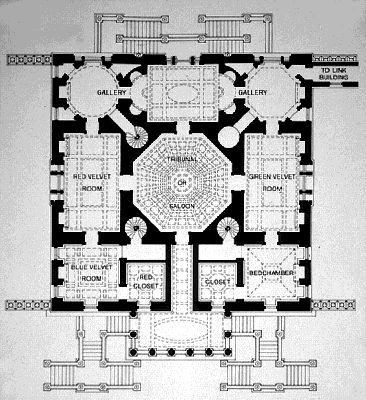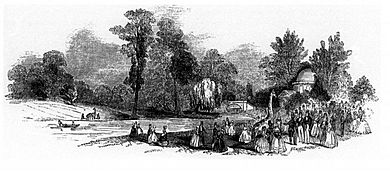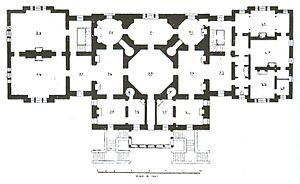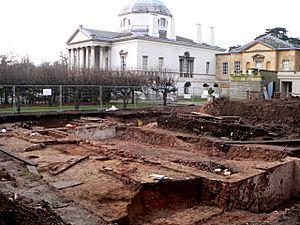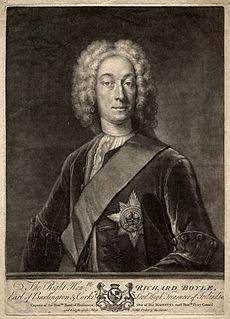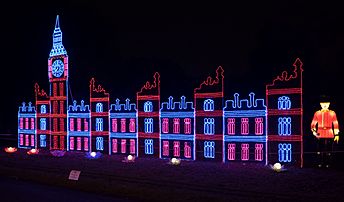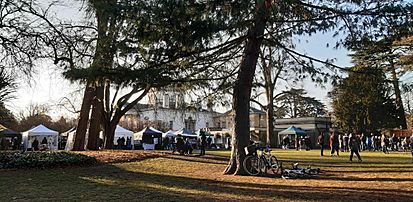Chiswick House facts for kids
Quick facts for kids Chiswick House |
|
|---|---|

View from forecourt
|
|
| General information | |
| Architectural style | Neo-Palladian |
| Location | Chiswick, London, England |
| Coordinates | 51°29′02″N 0°15′31″W / 51.48376°N 0.25866°W |
| Completed | 1729 |
| Owner | English Heritage |
| Design and construction | |
| Architect | Richard Boyle, 3rd Earl of Burlington |
Chiswick House is a beautiful country house, or villa, located in the Chiswick area of London, England. It's a great example of a style called Neo-Palladian architecture. This means it was designed to look like ancient Roman buildings, inspired by the Italian architect Andrea Palladio.
The house was designed and built by Richard Boyle, 3rd Earl of Burlington (1694–1753). It was finished in 1729. The house and its amazing gardens cover about 26.33 hectares (65 acres). The gardens were mostly created by the architect and landscape designer William Kent. They are one of the very first examples of the English landscape garden style.
After Lord Burlington passed away in 1753, the house went to his daughter's husband, William Cavendish, 4th Duke of Devonshire. Later, it was inherited by their son, William Cavendish, 5th Duke of Devonshire. His wife, Georgiana Spencer, loved Chiswick House. She used it as a quiet escape and a meeting place for the Whig political party. Important people like Prime Minister George Canning also passed away here.
During the 1800s, the house was rented out and became a mental hospital called the Chiswick Asylum starting in 1892. In 1929, the 9th Duke of Devonshire sold Chiswick House. It then became a fire station. The villa was damaged during World War II by a V-2 rocket. Today, Chiswick House is a very important historic building, known as a Grade I listed building. It is looked after by English Heritage.
Contents
The History of Chiswick House
Early Days of the House (around 1610–1682)
The first Chiswick House was a large house built in the Jacobean style. It was owned by Sir Edward Wardour. This house was built around 1610. It had four sides around an open courtyard. In 1624, Sir Edward sold the house to Robert Carr, 1st Earl of Somerset.
This original house was quite big. Records from 1664 show it had 33 fireplaces! It was also involved in the First English Civil War. The house was bought by Charles Boyle, 3rd Viscount Dungarvan in 1682.
The Boyle Family (1682–1758)
The Boyle family used the Jacobean house as a summer getaway. Their main home was Burlington House in central London. After a fire in 1725, Richard Boyle, 3rd Earl of Burlington, decided to build a brand new "villa." He built it to the west of the old Chiswick House.
Lord Burlington had a great love for Palladian architecture. He developed this passion during his trip to Italy in 1719. He studied the works of famous Italian architects like Palladio and Vincenzo Scamozzi. He also collected many drawings, including some by Palladio himself. Lord Burlington wanted to bring the style of ancient Roman buildings to England.
Burlington was a talented amateur architect. He designed the new villa with help from William Kent. Kent also played a big part in designing the gardens. Burlington built the villa to hold his amazing art collection. This collection was considered to have "some of the best pictures in Europe." The construction of the villa took place between 1726 and 1729.
After Lord Burlington passed away in 1753, his wife, Lady Dorothy Savile, and daughter, Charlotte, inherited the house. Charlotte had married William Cavendish, 4th Duke of Devonshire in 1748. Charlotte passed away in 1754, and Lady Burlington in 1758.
The Cavendish Family (1758–1929)
After Lady Burlington's death in 1758, the villa and gardens went to the Cavendish family. William Cavendish passed away in 1764. The property then went to his son, William, the 5th Duke of Devonshire. In 1774, William married Lady Georgiana Spencer, the Duchess of Devonshire. She loved spending time at Chiswick. She called it her "earthly paradise."
Georgiana often invited members of the Whig party to the house. They would have tea parties in the garden. In 1788, the Cavendish family tore down the old Jacobean house. They hired architect John White to add two wings to the villa. This was to create more living space. The Duchess was also responsible for building the Classical Bridge in 1774. It was designed by architect James Wyatt. She also had roses planted on the walls of the new wings. She passed away in 1806.
In 1813, a very long conservatory was built by Samuel Ware. It was 300 feet (91 meters) long! This building was used to grow exotic fruits and camellias. Gardener Lewis Kennedy created an Italian-style garden around it. In 1827, Prime Minister George Canning passed away in the same room where Charles James Fox had died in 1806.
Between 1862 and 1892, the Cavendish family rented out the villa. Many important people stayed there. These included the Duchess of Sutherland and the Prince of Wales.
Chiswick Asylum (1892–1928)
Starting in 1892, the 9th Duke of Devonshire rented the villa to Doctors Thomas Seymour and Charles Molesworth Tuke. They used it as a mental hospital called the Chiswick Asylum. It was for wealthy male and female patients. The asylum was known for treating its patients kindly. The wings of the house used for the asylum were removed in the 1950s. So, not much remains of this time. In 1897, two sphinx statues from the main gate were moved to Green Park. They were never returned.
Public Ownership (1929–Present)
The 9th Duke of Devonshire sold Chiswick House to Middlesex County Council in 1929. The money for the purchase came partly from public donations, including from King George V. The villa became a fire station during World War II. It was damaged during the war. On September 8, 1944, a V-2 rocket damaged one of its wings. Both wings were removed in 1956.
In 1948, a group called the Georgian Group worked hard to save the house from being destroyed. The house then came under the care of the Ministry of Works. Later, it was taken over by English Heritage.
In 2005, Hounslow Council and English Heritage created the Chiswick House and Gardens Trust. This trust now manages the villa and gardens. The trust took over in July 2010 after restoration work was finished. A grant from the Heritage Lottery Fund helped pay for the gardens' restoration in 2007. The gardens are open to the public for free from morning until evening.
Architecture of Chiswick House
Lord Burlington wanted Chiswick House to look like a real Roman villa. He didn't just want it to be a copy of Renaissance buildings. The house was inspired by buildings from the 1500s by Italian architects Andrea Palladio and Vincenzo Scamozzi. Many people say it was directly inspired by Palladio's Villa Capra "La Rotonda." However, Lord Burlington chose a different design for Chiswick.
Lord Burlington had many books by famous Italian Renaissance architects. He also owned drawings by Palladio that showed how Roman buildings were designed. These drawings helped him create the different shapes in Chiswick Villa. These shapes include octagons, circles, and rectangles. The steep dome of the villa is like the Pantheon in Rome.
The villa is made of brick, but its outside is covered in Portland stone. The beautiful Corinthian capitals on the front porch were carved by John Boson. They are copied from the Temple of Castor and Pollux in Rome. The short walls with ball decorations on either side of the villa look like old Roman town walls. They were inspired by Palladio's use of similar features. To show this connection, there are statues of Palladio and Inigo Jones in front of these walls.
The villa is shaped like a half-cube. It is 70 feet (21 meters) by 70 feet (21 meters) by 35 feet (11 meters) tall. When it was built, some people said it was "Too small to live in, and too big to hang to a watch." Others called it "the beautiful model."
Chiswick House Gardens
The gardens at Chiswick were designed to look like ancient Roman gardens. They were similar to Emperor Hadrian's Villa Adriana in Tivoli, Italy. From the 1720s, Burlington and Kent tried out new ideas for the gardens. They added things like a Ha-ha (a hidden ditch), classical garden buildings, statues, and winding paths. They also included waterfalls and water features.
A special outdoor theatre made of hedges, called an exedra, was designed by William Kent. It originally had ancient statues of Roman gentlemen. The lawn behind the house was created by 1745. It was planted with young Cedar of Lebanon trees. These trees are placed between stone urns designed by William Kent. There are also three sphinx statues facing the rising sun.
A lake was created around 1727 by making the Bollo Brook wider. The extra soil was used to build a raised walkway. This walkway allowed people to admire the gardens and see the nearby River Thames. A gate designed by Inigo Jones in 1621 was bought by Lord Burlington. He moved it from Beaufort House in Chelsea and rebuilt it in the Chiswick gardens in 1738. The Classic Bridge was built for Georgiana Spencer in 1774. It was designed by James Wyatt.
The kitchen garden was first created in 1682. Its ownership changed many times, and the garden became run down. In 2005, local volunteers helped restore it. In 2009, the kitchen garden received a grant from the Big Lottery Fund. This money helped fund a community gardener and keep the kitchen garden running.
Freemasonry Connections
Chiswick House has been connected to Freemasonry. Some experts believe it might have been used as a private Masonic Lodge or Temple. Many of the ceiling paintings by William Kent in the Gallery and other rooms have symbols related to Freemasonry. The sizes of some upstairs rooms also match important biblical buildings in Freemasonry.
Lord Burlington was an important Freemason. His name is mentioned in Masonic books and poems. Experts like Pat Rogers believe Chiswick House was a symbolic temple. It was based on a type of Freemasonry called Royal Arch Freemasonry. Lord Burlington's library list also shows he owned many books by Freemasons. After Chiswick Villa was finished, Burlington inspired other Masonic architects. They designed other buildings like Holkham Hall and the Mansion House.
Famous Visitors
Many important people have visited Chiswick House throughout its history. These include famous thinkers from the 'Age of Enlightenment' like Voltaire and Jean-Jacques Rousseau. Future US Presidents John Adams and Thomas Jefferson also visited. Other notable guests include Benjamin Franklin, the Italian statesman Giuseppe Garibaldi, and Russian Tsars Nicholas I and Alexander I.
Even royalty like Queen Victoria and Prince Albert of Saxe-Coburg visited. Famous writers like Sir Walter Scott also came to the house. Prime Ministers William Ewart Gladstone and Sir Robert Walpole were also guests.
On May 20, 1966, the Beatles visited Chiswick House. They filmed promotional videos for their songs "Paperback Writer" and "Rain" there. Scenes were shot in the conservatory, the walled garden, and by the exedra.
Events at Chiswick House
Since the gardens were restored, many seasonal events are held at Chiswick House each year. These include a Camellia flower show and open days in the walled kitchen garden. There have also been a circus and a magic lantern festival.
-
A sculpture of the Palace of Westminster at a magic lantern festival in the gardens
See also
 In Spanish: Chiswick House para niños
In Spanish: Chiswick House para niños


